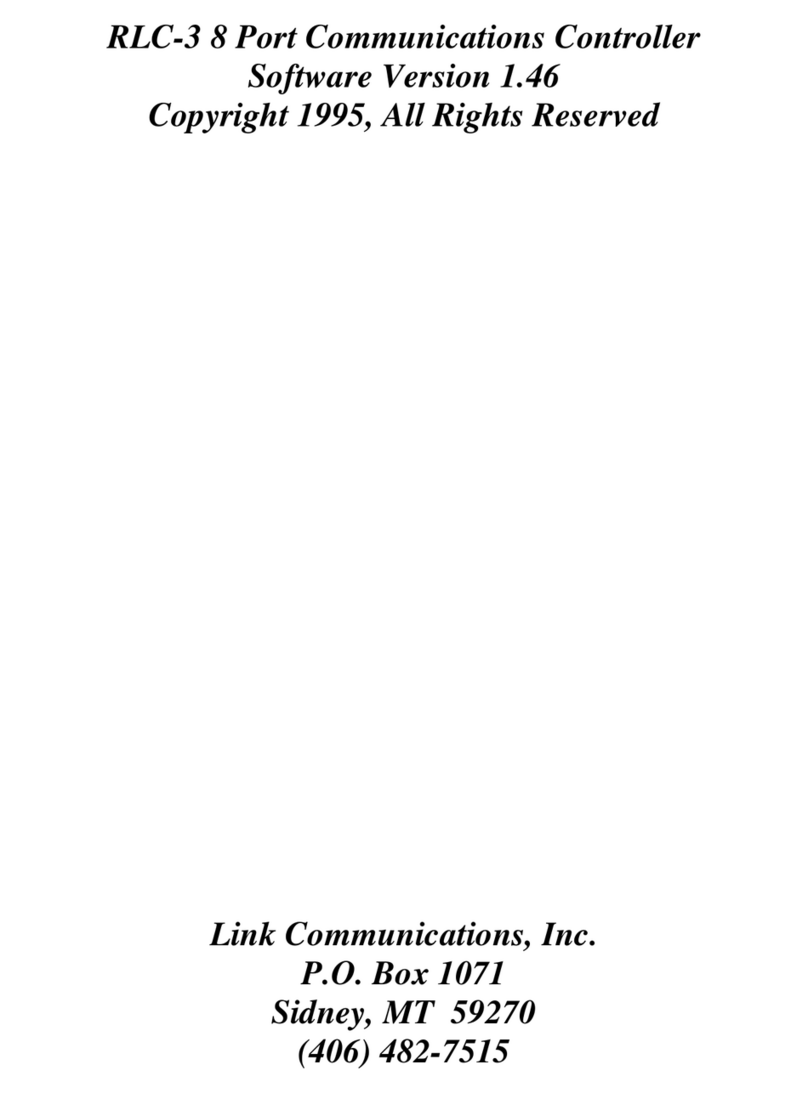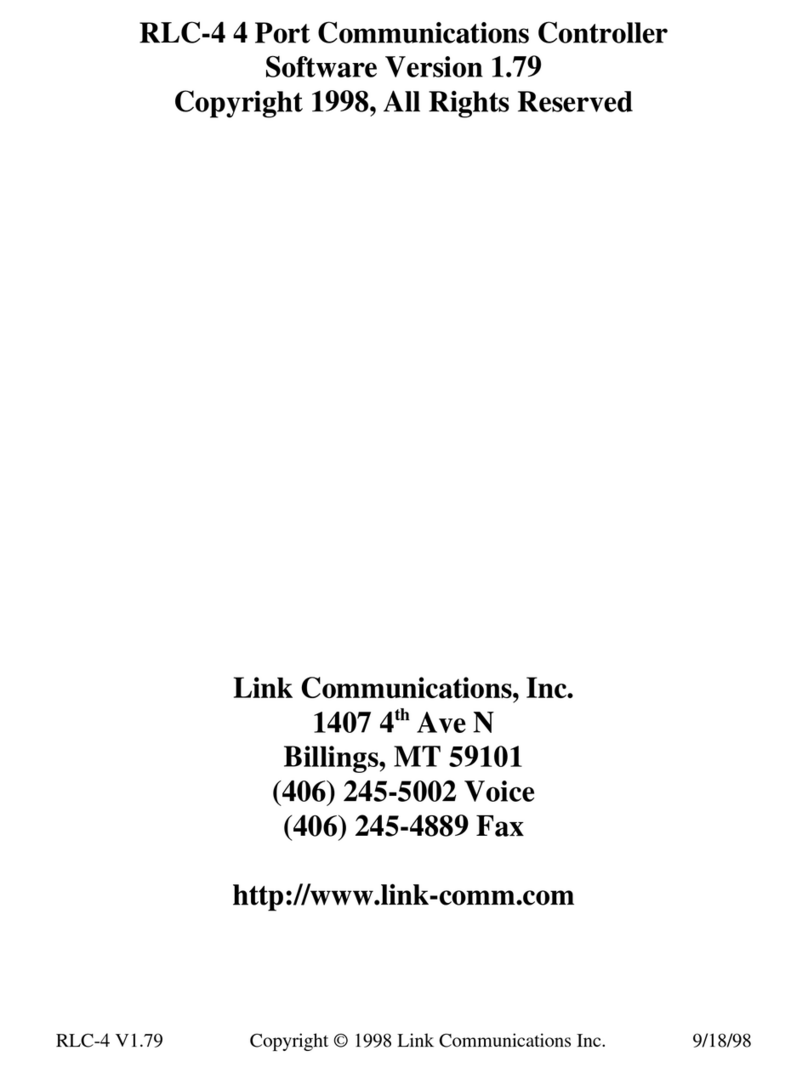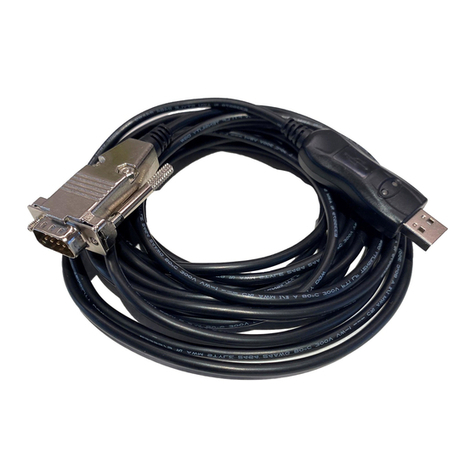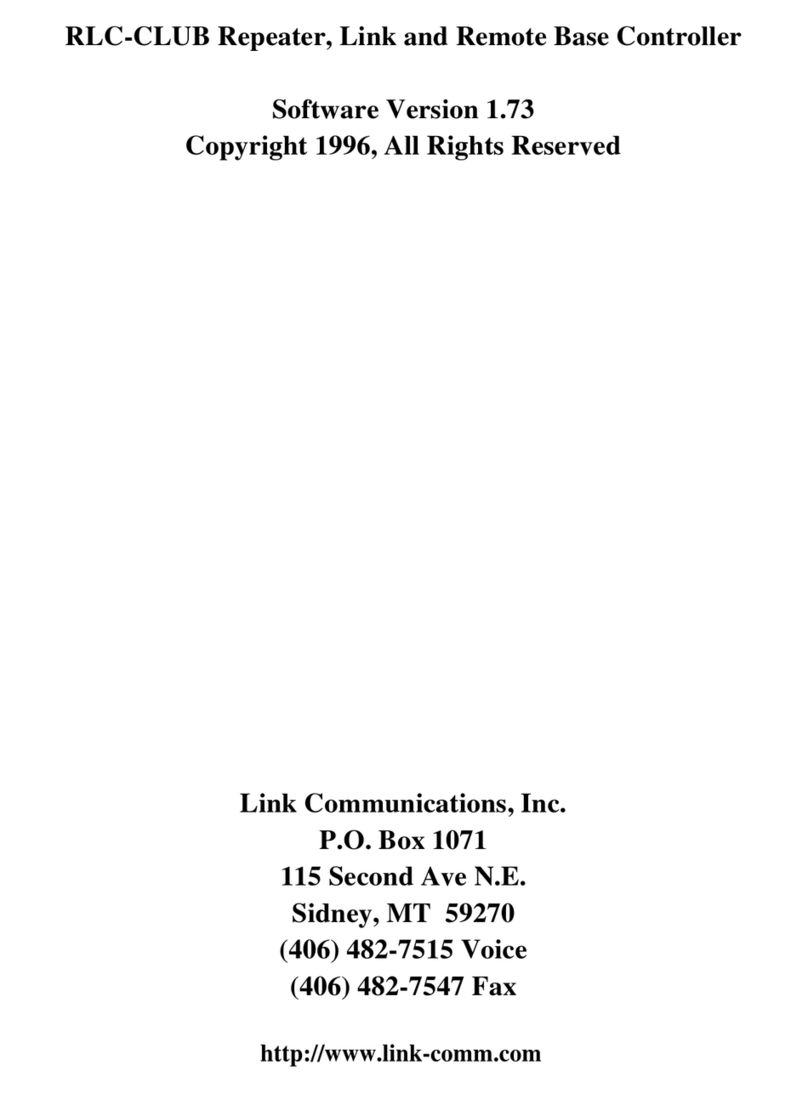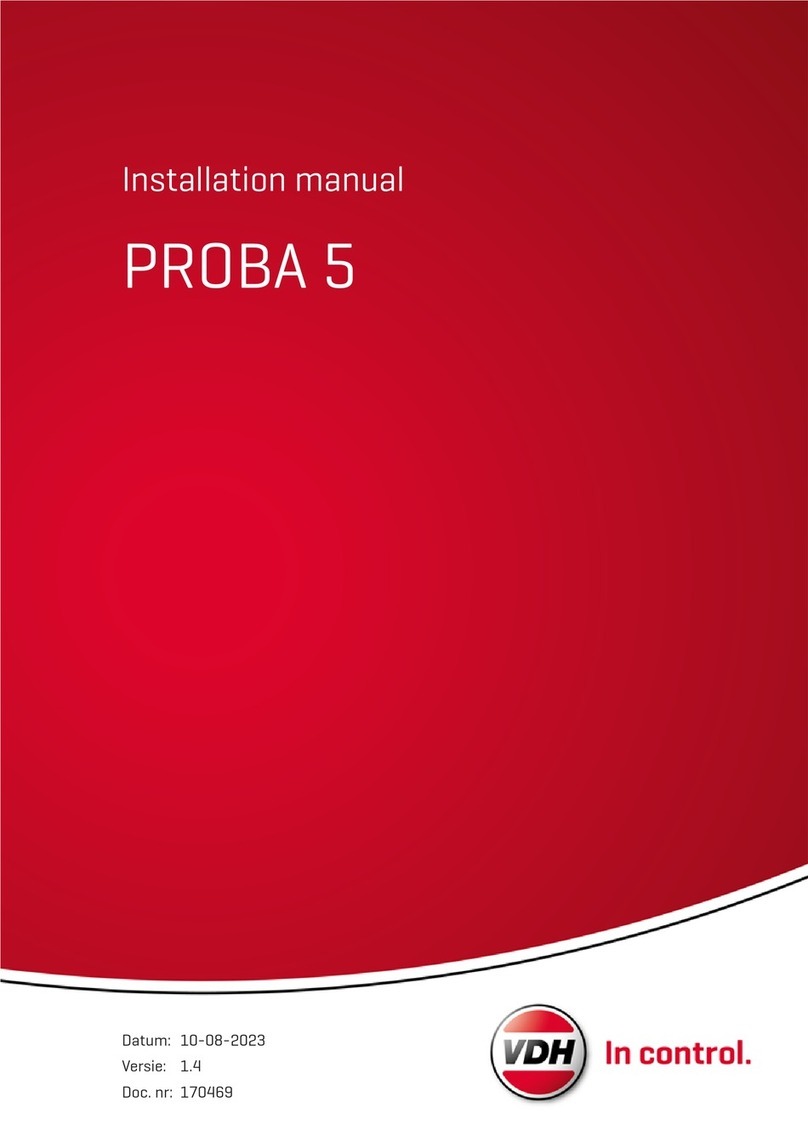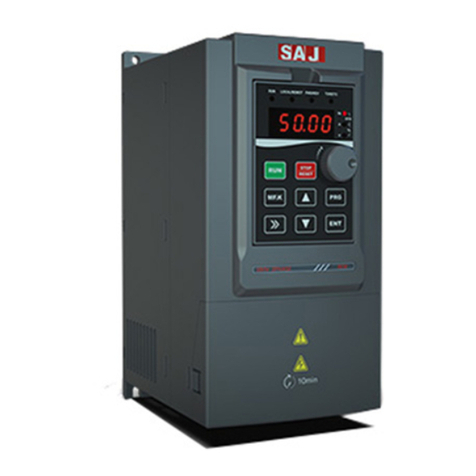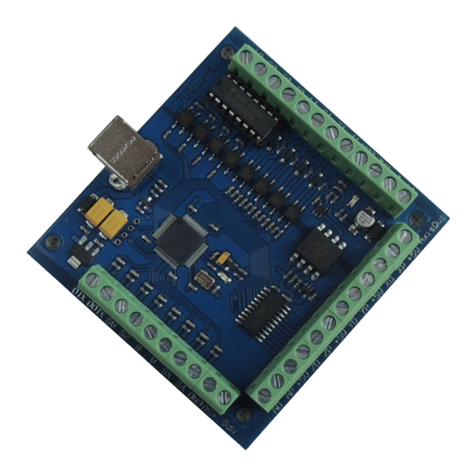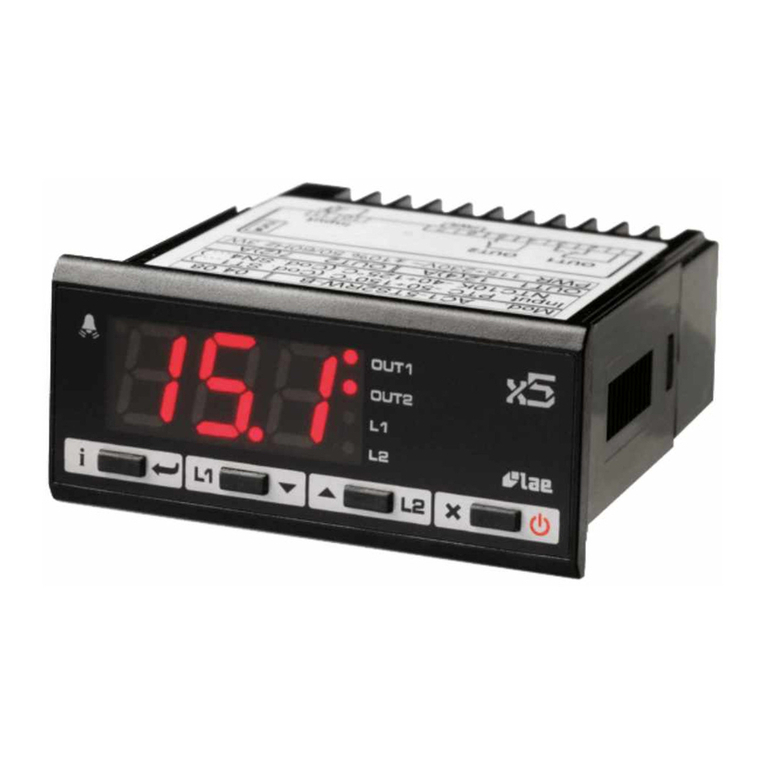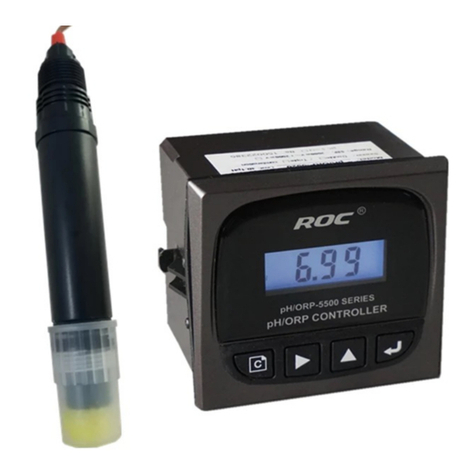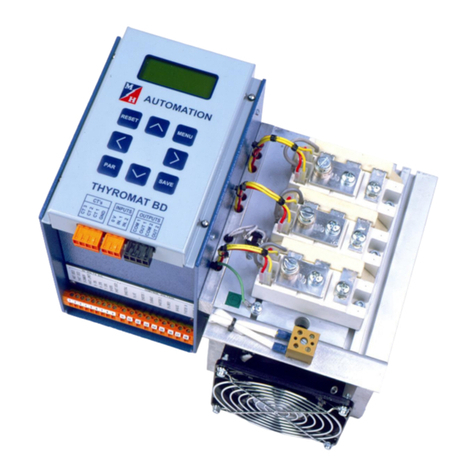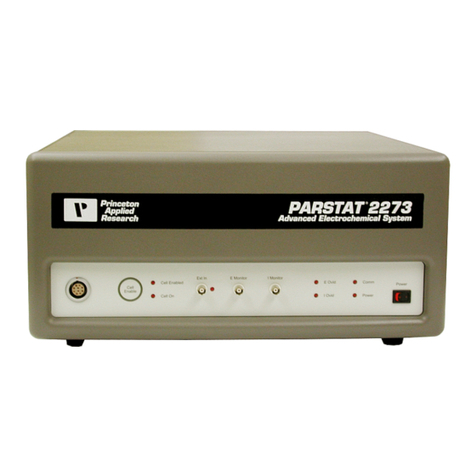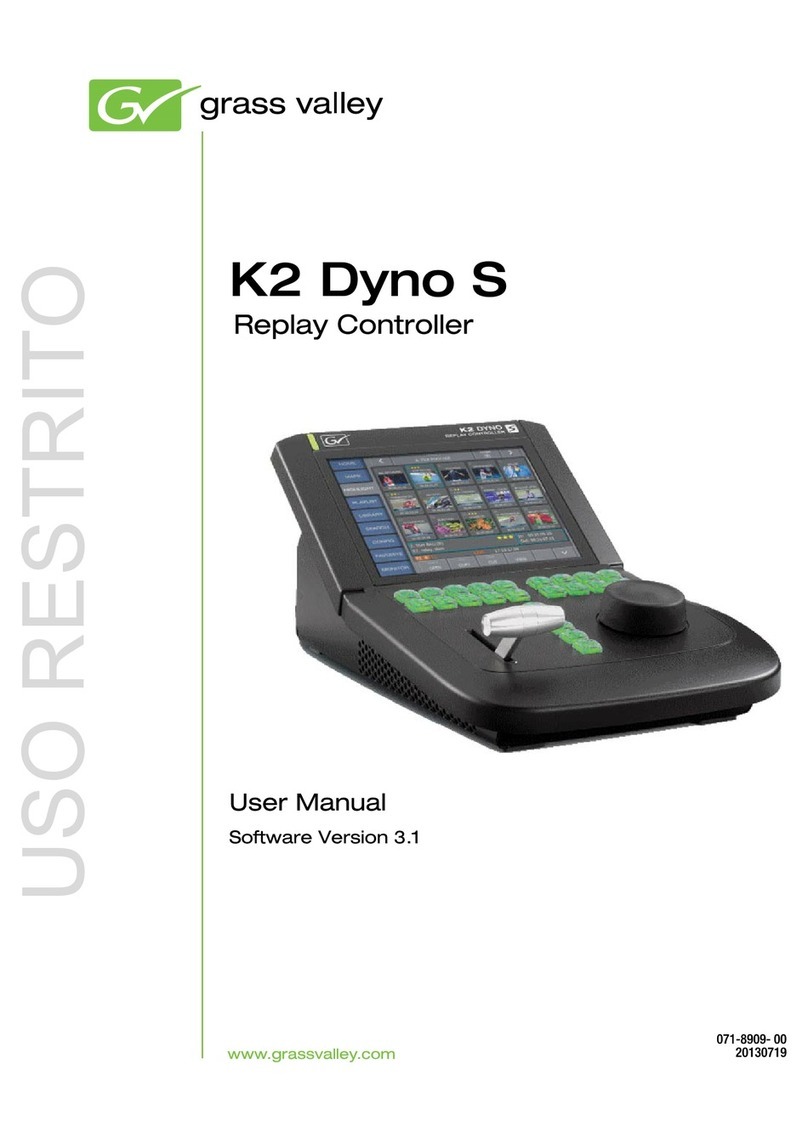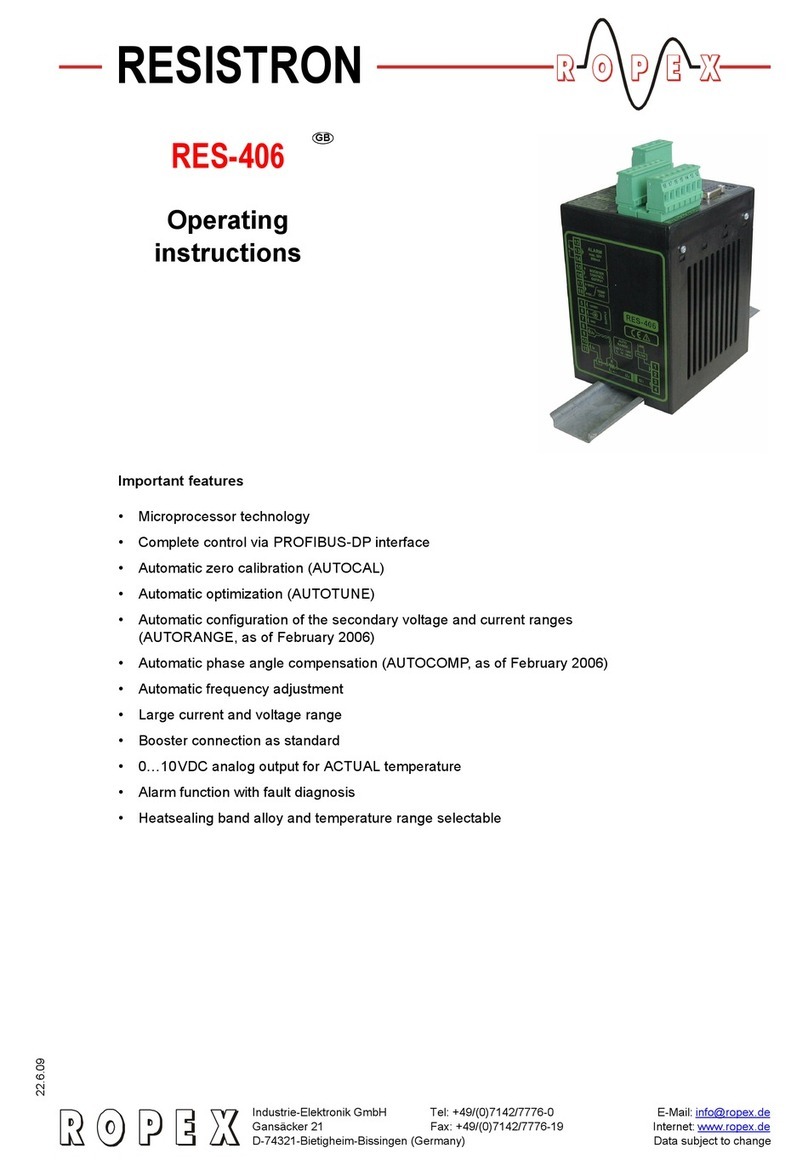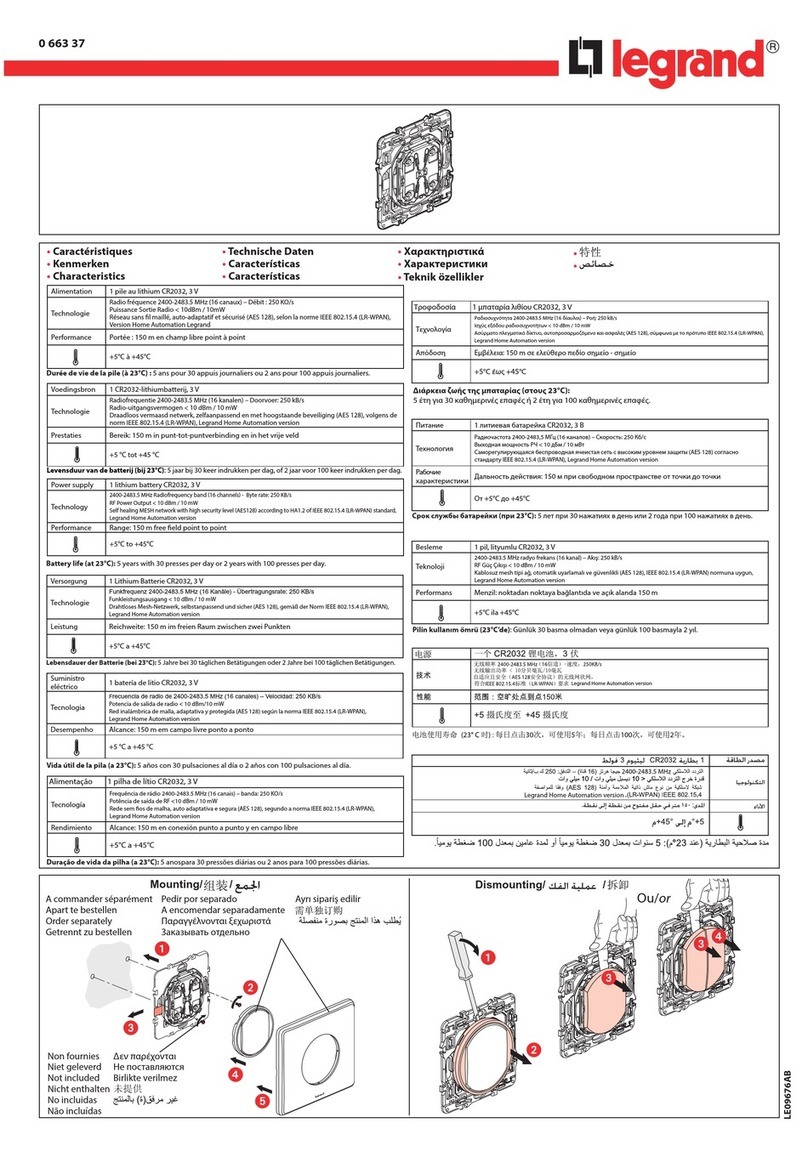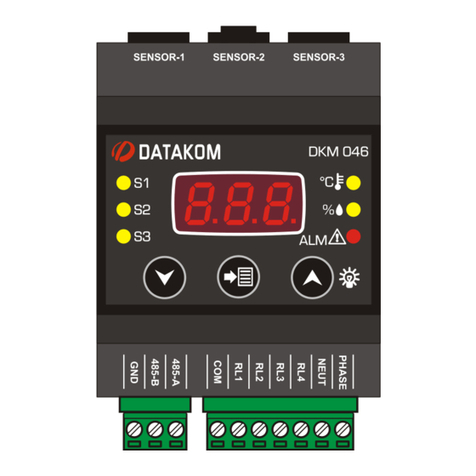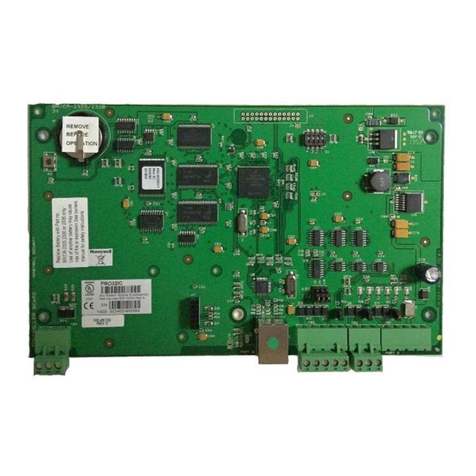Link Communications RLC-3 User manual

RLC-3 8 Port Communications Controller
Software Version 1.77
Copyright 1997, All Rights Reserved
Link Communications, Inc.
115 Second Ave N.E.
P.O. Box 1071
Sidney, MT 59270
(406) 482-7515 Voice
(406) 482-7547 Fax
http://www.link-comm.com


Version 1.77 Copyright © 1997 Link Communications Inc. 8/7/97
Introduction:
Congratulations, you have purchased a very powerful tool for your group's repeater. The RLC-3
may seem complicated and intimidating at first, but don't worry. Setting it up and programming it
are easy and straightforward, once you have read the manual. Please take the time to read it before
you try to start programming. This will save you a lot of confusion and frustration, as it should
answer most of your questions.
The RLC-3 communications controller supports up to 8 radio ports and two I/O boards (8 analog
voltage inputs, 8 logical (dry contact) inputs, and eight MOSFET output drivers each). The radio
ports can be configured to require one of several combinations of COR and PL inputs for access.
The RLC-3 has a DTMF decoder per radio port card, thereby supporting DTMF control from all
radio ports of the controller. Synthesized voice prompts the users in the programming of the
controller's variables, provides voice ID's and alarms based on the inputs, etc. The autopatch
includes 1000 programmable autodial numbers, cover tone, directed reverse patch and telephone
control. DVR, HF and VHF/UHF remote base support. All command codes, timer values, and
messages are programmable by owner. Each message can contain combinations of Morse code
characters, synthesized speech words, sound effects, DVR tracts, etc. The controller can be
programmed using DTMF from any of the radio ports, using DTMF from a telephone (using the
reverse autopatch), or from a computer using a serial cable or modem. The controller contains
several hundred command macros.. There is a clock/calender time chip with internal battery
backup for years of non-interrupted time piece operation. The timed event scheduler can be used
to automatically load configurations based on time of day and day of week settings. All input,
output, analog and radio interfacing signals can be assigned automatic event calls to allow
unattended functional operations.
This manual consists of three main sections: setup and interfacing, programming and commands,
and the appendices with commonly referenced tables and charts. A glossary has also been included
at the end to explain some of the terms and abbreviations that are used throughout the manual.
We have attempted to explain everything in a way that is easy to understand, but some questions
are inevitable. If you have carefully read the manual and still have questions, call us at (406)
Link Communications Inc.
115 Second Ave N.E.
P.O. Box 1071
Sidney, MT 59270

Version 1.77 Copyright © 1997 Link Communications Inc. 8/7/97

Version 1.77 Copyright © 1997 Link Communications Inc. 8/7/97
Table of Contents
Command List by Number ................................................. XIII
Limited Warranty ....................................................... XVII
User Survey .............................................................XIX
Chapter 1: Getting Started ..................................................1-1
Setup, Interfacing and Adjustment ........................................1-1
What Each Connector is For .............................................1-1
Serial Port Interfacing ..................................................1-8
Reset and Power Up ..................................................1-12
Entering Commands ..................................................1-12
Error Messages ......................................................1-14
How to Configure a Port as a Repeater ....................................1-16
Example 1-1: Configuring a Port as a Repeater or Link ........................1-17
Example 1-2: Configuring a Port's COR/PL Polarity ..........................1-18
Troubleshooting the Controller ..........................................1-19
Chapter 2: Port Connection Commands .......................................2-1
"Connected Ports" ....................................................2-1
Turning a Repeater Off .................................................2-1
000: Connect one Port to another Port .....................................2-4
001: Monitor one Port from another Port ...................................2-5
002: Disconnect one Port from another Port .................................2-6
003,004: Recall a Port's Connections ......................................2-7
005: Set Receiver and DTMF Decoder Conditions ............................2-8
006: Recall Receiver and DTMF Decoder Conditions .........................2-10
009: Recall Entire Controller's Audio Crosspoint ............................2-11
013: Recall Radio Port Card Conditions ...................................2-12
061: Disconnect all Ports from a Radio Port ................................2-13
155: Enable or Disable PTT for a Port ....................................2-14
156: Recall Which PTT are Enabled ......................................2-14
Chapter 3: Audio and DTMF configurations ....................................3-1
007: Configure DTMF Mute/Cover Tone/Bypass .............................3-3
008: Check DTMF Mute/Cover Tone/Bypass Settings .........................3-4
Chapter 4: Timers .........................................................4-1
020: Program a Selected Timer ...........................................4-2
021: Recall a Timer Value ..............................................4-22
022: Start a Timer ....................................................4-22
023: Stop a Timer ....................................................4-22
025: Sets the Time of Day Clock ........................................4-23
026: Recall the Time of Day Clock in Male Speech ...........................4-23
027: Recall the Time of Day Clock in Female Speech .........................4-23

Version 1.77 Copyright © 1997 Link Communications Inc. 8/7/97
028: Sets the Date ................................................... 4-24
029: Recall the Date .................................................. 4-25
Chapter 5: Command Names ............................................... 5-1
How Command Names and Command Numbers are Used: ...................... 5-1
010: Re-Program Command Names ....................................... 5-5
011: Recall Command Name ............................................ 5-8
012: Find Commands Named ... ......................................... 5-8
Blocking Execution from Certain Ports .................................... 5-9
130: Block Command Execution From Port ............................... 5-10
131: Allow Command Execution From Port ............................... 5-10
132: Recall Blocked Ports ............................................. 5-10
Chapter 6: CW, DTMF, Voice and DVR Messages ............................... 6-1
030: Send a CW Message .............................................. 6-2
031: Send a DTMF Sequence ............................................ 6-3
036: Send a Voice Message ............................................. 6-4
066: Send a Voice Message Using English Words ............................ 6-5
040: Send One or Two Tone Sequence .................................... 6-6
Note about Courtesy Beeps ............................................. 6-7
041: Courtesy Beep Enable/Disable for a Selected Transmitter ................... 6-9
042: Set CW Speed for a Selected Port ................................... 6-10
043: Set CW 2-Tone Frequencies for a Selected Port ........................ 6-11
044: Set Up DTMF Regenerate Parameters: Not Active ...................... 6-12
051: Start Dial-Tone ................................................ 6-13
063: Send a Polite Voice Message ....................................... 6-14
064: Send a Polite Voice Msg, If Interrupted Execute Cmd .................... 6-15
163: Keypad Test ................................................... 6-16
The Digital Voice Recorder ............................................ 6-17
What the DVR is: .................................................... 6-17
Public Mailboxes: .................................................... 6-17
Private Mailboxes: ................................................... 6-18
Interfacing: ........................................................ 6-18
Memory Installation and Testing: ........................................ 6-18
Audio Quality/Recording Time: ......................................... 6-19
Adjusting the DVR: .................................................. 6-19
The Audio Check Command: ........................................... 6-20
Recording DVR Tracks: ............................................... 6-20
Playing Messages: ................................................... 6-21
Erasing Tracks: ..................................................... 6-21
Recording the Prompting Tracks: ........................................ 6-22
The Serial Interface: .................................................. 6-22
182: Select DVR Type ............................................... 6-24
170: Record and Play Audio Test ....................................... 6-24
171: Record DVR Track (non-prompted) ................................. 6-24
172: Record DVR Track (prompted) ..................................... 6-25
173: Play DVR Tracks ............................................... 6-25
174: Erase DVR Tracks .............................................. 6-26

Version 1.77 Copyright © 1997 Link Communications Inc. 8/7/97
175: Record Public Mail ..............................................6-27
176: Check Public Mailboxes ...........................................6-27
177: Retrieve Public Mail ..............................................6-27
178: Erase Public Mail ................................................6-28
179: Record Private Mail ..............................................6-28
180: Retrieve Private Mail .............................................6-28
181: Erase Private Mail ...............................................6-29
183: Record a Message on the Small DVR .................................6-30
184: Playback a Small DVR Message(s) ...................................6-31
185: Erase Small DVR Message(s) ......................................6-31
Chapter 7: Serial Port Commands ............................................7-1
024: Set Up RS-232 Serial Baud Rates .....................................7-3
060: Set Up Serial Port Options ..........................................7-4
032: Send Serial Message out the Main Serial Port ............................7-5
162: Always Send Serial Message out the Main Serial Port .....................7-5
169: Always Send Serial out Main Serial Port by ASCII Code ...................7-6
033: Send Serial Message out Radio Card's Serial Port .........................7-7
034: Send Serial out Radio Card's Serial Port by ASCII Code ....................7-8
138: Direct SPI Send out of Radio Card's Serial Port ..........................7-9
Chapter 8: Macros .........................................................8-1
How Macros Get Executed: .............................................8-1
What a macro is: ......................................................8-1
Limits on Macros: .....................................................8-2
200..499: Execute an Automatic Macro ....................................8-4
500..999: Execute a User Macro .........................................8-4
053: Program a Single Command Macro Sequence ...........................8-5
054: Recall Macro Contents .............................................8-6
055: Delete Macro ....................................................8-7
056: Append a Command to a Macro ......................................8-7
057: Copy a Macro ...................................................8-7
058: Delete a Command in a Macro .......................................8-8
059: Insert a Command in a Macro .......................................8-8
Automatic Macro Explanations ...........................................8-9
Chapter 9: Pre-Access Commands ............................................9-1
What preaccess is: ....................................................9-1
What you need to know: ................................................9-1
070: Configure a Repeater for Preaccess ...................................9-2
071: Configure a Link for Preaccess .......................................9-3
072: Disable Preaccess Requirement for a Port ..............................9-4
073: Recall Ports with Preaccess Requirement ...............................9-4
074: Allow Access To a Port that Requires Preaccess .........................9-4
075: Set Stop Access Conditions .........................................9-5
076: Recall Stop Access Conditions .......................................9-6
077: Isolate a Port from the Rest of the System ..............................9-6

Version 1.77 Copyright © 1997 Link Communications Inc. 8/7/97
Chapter 10: Scheduler .................................................... 10-1
How the Scheduler Works: ............................................ 10-1
082: Set Up a Scheduler Event ......................................... 10-2
083: Recall a Scheduler Event .......................................... 10-5
084: Enable/Disable a Scheduler Event .................................... 10-6
Chapter 11: The ID System ................................................ 11-1
How the ID's Work: .................................................. 11-1
Polite Voice ID's: .................................................... 11-1
To Program Your Own ID's: ........................................... 11-2
More about Programming ID's: ......................................... 11-2
ID Timing: ......................................................... 11-3
085: Enable/Disable IDing a Port ....................................... 11-4
086: Recall Which Ports have ID's Enabled ................................ 11-4
087: Set Random or Rotating Pending ID's ................................ 11-5
088: Recall Random or Rotating Pending ID Selection ....................... 11-5
Chapter 12: I/O Board .................................................... 12-1
About the I/O Board: ................................................. 12-1
Logical Input Lines .................................................. 12-1
Logical Output Lines: ................................................ 12-1
Analog Input Lines: ...................................... 12-2
I/O Board Pin-Out ................................................... 12-4
Analog Input Lines ....................................... 12-4
Logical Input Lines ....................................... 12-4
Latched Output Lines ..................................... 12-4
090: Read Whether Input Line is High or Low ............................. 12-5
091: Execute Input Line High or Low Macro .............................. 12-5
092: Enable/Disable Input Line Alarm .................................... 12-6
093: Turn Output Line On ............................................ 12-7
094: Turn Output Line Off ............................................ 12-7
095: Recall Whether Output Line is On or Off .............................. 12-8
100: Read Analog Input Line ........................................... 12-9
101: Set Resolution For Analog Input ................................... 12-10
102: Set Conversion Ratio For Analog Input .............................. 12-12
Custom Analog Conversion Ratios: .......................... 12-13
103: Calibrate an Analog Input ........................................ 12-15
104: Set an Analog Alarm ............................................ 12-16
105: Set Analog Alarm Hysteresis ...................................... 12-17
106: Enable/Disable an Analog Alarm ................................... 12-19
107: Recall Analog Lines in Alarm ..................................... 12-19
108: Recall Analog Line Configuration .................................. 12-20
160: Clear Analog High/Lows ......................................... 12-21
161: Set Analog Smoothing Factor ..................................... 12-22
109: Configure Wind Speed Reading .................................... 12-23

Version 1.77 Copyright © 1997 Link Communications Inc. 8/7/97
Chapter 13: Autopatch Routines .............................................13-1
Configuring the Autopatch: .............................................13-1
Autopatch Up Commands: .............................................13-1
Using '*' for the Autopatch Up Command: .................................13-1
Hanging Up: ........................................................13-2
Connected Ports: ....................................................13-2
Predial Digits: .......................................................13-2
The Autodialer: ......................................................13-2
Limiting Call Length: .................................................13-3
How the Dialing Tables Work: ..........................................13-3
Other Commands that Affect the Autopatch: ................................13-4
110: Configure the Autopatch ..........................................13-6
111: Manual Off Hook ................................................13-7
112: Normal Forward Dial .............................................13-7
113: Forward Dial with no Long Distance Checking .........................13-8
114: Hang up the Autopatch ...........................................13-9
115: Possibly Hang up the Autopatch .....................................13-9
116: Set / Recall the Predial Digits and Timing .............................13-10
119: Set Allowed Numbers Table Slot ...................................13-11
120: Recall Allowed Numbers Table Slot .................................13-11
121: Set Nuisance Numbers Table Slot ..................................13-12
122: Recall Nuisance Numbers Table Slot ................................13-12
123: Test Dialing Tables .............................................13-13
124: Set Autodial Slot ...............................................13-13
125: Recall Autodial Slot .............................................13-14
126: Send Predial Digits / Callsign for Autodial Slot? ........................13-14
127: Enable/Disable an Autodial Slot ....................................13-15
128: Set Full or Half-Duplex Patch Audio for a TX .........................13-15
129: Recall Full or Half-Duplex Patch Audio for a TX .......................13-16
133: Set up Reverse Patch ............................................13-17
134: Access Reverse Patch Control Mode ................................13-18
135: Answer Reverse Patch ...........................................13-18
136: Set up Reverse Autopatch Ring ....................................13-19
137: Autodial Only .................................................13-19
Chapter 14: Doug Hall RBI-1 and RLC-ICM Routines ...........................14-1
What the RBI-1 is: ...................................................14-1
What the RLC-ICM is: ................................................14-1
Interfacing and Setup: .................................................14-1
Using the RBI-1 or RLC-ICM: ..........................................14-2
Building the RBI-1/RLC-ICM Cable ..........................14-5
139: Set Up the RLC-Icom Interface .....................................14-8
RLC-ICM Internal Operation Test Points .................................14-11
140: Set Port for RBI-1 or RLC-ICM ...................................14-12
141: Set Band Unit for RBI-1 or RLC-ICM ...............................14-13
142: Set Frequency (and Offset) for RBI-1 or RLC-ICM .....................14-14
143: Set Offset for RBI-1 or RLC-ICM ..................................14-15
144: Set Offset and Frequency Readback Styles ............................14-16

Version 1.77 Copyright © 1997 Link Communications Inc. 8/7/97
145: Set Power Level for RBI-1 ....................................... 14-17
146: Set PL Frequency for RBI-1 or RLC-ICM ........................... 14-18
147: Turn PL Encode Off/On for RBI-1 or RLC-ICM ....................... 14-19
148: Turn PL Decode Off/On for RBI-1 or RLC-ICM ...................... 14-19
149: Recall Band, Frequency & Offset for RBI-1 or RLC-ICM ................ 14-20
150: Recall All RBI-1 or RLC-ICM Settings .............................. 14-20
151: Turn Radio Power On or Off for RBI-1 .............................. 14-21
152: Goto Radio Memory Channel for the RBI-1 .......................... 14-22
Chapter 15: Serial Controlled (HF) Radio Support .............................. 15-1
HF Radio Interfacing ................................................. 15-1
HF Radio Control: ................................................... 15-2
195: Configure HF Mode ............................................. 15-4
196: Configure HF Radio ............................................. 15-5
197: Set/Recall Transmit/Scan Band Edges ................................ 15-7
198: HF Mode Enable ................................................ 15-9
HF Remote Base Keypad Definition: ......................... 15-10
199: Enter HF Command (w/o being in HF mode) ......................... 15-16
Chapter 16: Special Audio Routing Commands ................................ 16-1
037: Set Audio Routing Variable for Commands In a Macro .................. 16-2
038: Kill All Responses Following This Command ........................... 16-3
065: Restore Audio Routing Variable (Undo 037 and 038) .................... 16-4
039: Recall the Ports in the Current Audio Routing Variable ................... 16-5
050: Set Up or Recall Default Audio Routing Variables ...................... 16-6
Chapter 17: Special Control Commands ...................................... 17-1
035: Remotely Reset the Controller ...................................... 17-2
078: Set Command Entry Options for a Port ............................... 17-3
079: Recall Command Entry Options for a Port ............................. 17-5
080: Execute Command by Number ...................................... 17-6
164: Recall Software Version .......................................... 17-8
165: Reset COP Watchdog Timer ....................................... 17-8
166: Display Status Screen ............................................ 17-9
167: Do Nothing .................................................... 17-9
014..019: Not Currently Used ......................................... 17-10
049: Not Currently Used ............................................. 17-10
052: Not Currently Used ............................................. 17-10
067..069: Not Currently Used ......................................... 17-10
081, 081: Not Currently Used ......................................... 17-10
089: Not Currently Used ............................................. 17-10
096..099: Not Currently Used ......................................... 17-10
109: Not Currently Used ............................................. 17-10
117..118: Not Currently Used ......................................... 17-10
153..154: Not Currently Used ......................................... 17-10
168: Not Currently Used ............................................. 17-10
192..194: Not Currently Used ......................................... 17-10
197: Not Currently Used ............................................. 17-10

Version 1.77 Copyright © 1997 Link Communications Inc. 8/7/97
Chapter 18: 1000 User Structure .............................................18-1
The Password System .................................................18-1
Method #1 - No Passwords: ...............................18-3
Method #2 - Fixed Passwords: ..............................18-3
Method #3 - Challenge Passwords: ..........................18-3
Method #4 - Challenge Passwords with Decoy Digits: ............18-4
186: Set up User Password ............................................18-6
187: User Log-on ...................................................18-7
188: Recall Who Is Logged In ..........................................18-8
189: User Log-off ...................................................18-8
190: Assign a User Level to a Command ..................................18-9
191: Assign a Callsign to a User ........................................18-10
Chapter 19: The Beaconing System ..........................................19-1
045: Setup Beacon Table ..............................................19-2
046: Start Beacon ....................................................19-3
047: Cancel Beacon ..................................................19-3
048: Start Beacon Using English Words ...................................19-4
Chapter 20: Event Triggers .................................................20-1
157: Set Up Event Trigger .............................................20-2
158: Recall Event Trigger Setting .......................................20-2
159: Enable/Disable Event Trigger .......................................20-2
Appendix A: The Audio Routing Variable System .............................. A-1
Explanation of the System .............................................. A-1
Suppressing Command Responses in Macros: ............................... A-2
Appendix B: Voice Word Table ............................................. B-1
Appendix C: CW Code Table ............................................... C-1
Appendix D: Reset and Initialization ......................................... D-1
Appendix E: Controlling a Rotor ............................................ E-1
Appendix F: Programming with the Serial Port .................................F-1
Voice responses to commands entered serially: ...............................F-2
Using a serial upload file: ...............................................F-2
Note about spaces in serial commands: .....................................F-3
Note about comments in serial upload files: ..................................F-3
Note about capital letters: ...............................................F-3
Note about download speeds: ............................................F-3
Serial responses to commands entered from a radio: ...........................F-4
Very Long Serial Commands: ............................................F-4
Appendix G: ASCII Chart ................................................. G-1

Version 1.77 Copyright © 1997 Link Communications Inc. 8/7/97
Appendix H: Using the LM335 Temperature Sensor .............................H-1
Appendix I: Software Problem and Request Form ............................... I-1
Appendix J: Hardware Reference Section ..................................... J-1
Important Connections: ................................................ J-1
Main Board .............................................. J-1
Radio Board ............................................. J-2
I/O Board ............................................... J-3
Power Board LED Definitions ............................... J-4
Bill of Materials ...................................................... J-5
RLC-3 Main Controller Board Parts ........................... J-6
RLC-3 Radio Port Parts .................................... J-8
RLC-3 I/O Board Parts ..................................... J-9
RLC-3 Autopatch Board ................................... J-10
RLC-3 Power Board Parts ................................. J-11
Component Layouts and Schematic Diagrams .............................. J-12

Version 1.77 Copyright © 1997 Link Communications Inc. 8/7/97
Command List by Number
000: Connect one Port to another Port ...........................................2-4
001: Monitor one Port from another Port .........................................2-5
002: Disconnect one Port from another Port .......................................2-6
003,004: Recall a Port's Connections ............................................2-7
007, 008: Configure, Check DTMF Mute on a Selected Port ...................... 3-3, 3-4
009: Recall Entire Controller's Audio Crosspoint ..................................2-11
010: Re-Program Command Names .............................................5-5
011, 012: Recall Information about a Command Name ...............................5-8
013: Recall Radio Port Card Conditions .........................................2-12
014..019: Not Currently Used ...............................................17-10
020: Program a Selected Timer ................................................4-2
022: Start a Timer .........................................................4-22
023: Stop a Timer .........................................................4-22
024: Set Up RS-232 Serial Baud Rates ...........................................7-3
025: Sets the Time of Day Clock ..............................................4-23
026: Recall the Time of Day Clock in Male Speech .................................4-23
027: Recall the Time of Day Clock in Female Speech ...............................4-23
028: Sets the Date .........................................................4-24
029: Recall the Date ........................................................4-25
030: Send a CW Message .....................................................6-2
031: Send a DTMF Sequence ..................................................6-3
032: Send Serial Message out the Main Serial Port ..................................7-5
033: Send Serial Message out Radio Card's Serial Port ...............................7-7
034: Send Serial out Radio Card's Serial Port by ASCII Code .........................7-8
035: Remotely Reset the Controller ............................................17-2
036: Send a Voice Message ...................................................6-4
037: Set Audio Routing Variable for Commands In a Macro .........................16-2
038: Kill All Responses Following This Command .................................16-3
039: Recall the Ports in the Current Audio Routing Variable .........................16-5
040: Send One or Two Tone Sequence ..........................................6-6
041: Courtesy Beep Enable/Disable for a Selected Transmitter .........................6-9
042: Set CW Speed for a Selected Port .........................................6-10
043: Set CW 2-Tone Frequencies for a Selected Port ..............................6-11
044: Set Up DTMF Regenerate Parameters: Not Active ............................6-12
045: Setup Beacon Table ....................................................19-2
046: Start Beacon ..........................................................19-3
047: Cancel Beacon ........................................................19-3
048: Start Beacon Using English Words .........................................19-4
049: Not Currently Used ...................................................17-10
050: Set Up or Recall Default Audio Routing Variables .............................16-6
051: Start Dial-Tone .......................................................6-13
052: Not Currently Used ...................................................17-10
053: Program a Single Command Macro Sequence .................................8-5
054: Recall Macro Contents ..................................................8-6
055: Delete Macro .........................................................8-7
056: Append a Command to a Macro ...........................................8-7

Version 1.77 Copyright © 1997 Link Communications Inc. 8/7/97
057: Copy a Macro ......................................................... 8-7
058: Delete a Command in a Macro ............................................ 8-8
059: Insert a Command in a Macro ............................................. 8-8
060: Set Up Serial Port Options ............................................... 7-4
061: Disconnect all Ports from a Radio Port ..................................... 2-13
062: Change the Beginning of Command Names ................................... 5-7
063: Send a Polite Voice Message ............................................ 6-14
064: Send a Polite Voice Message and if Interrupted... ............................. 6-15
065: Restore Audio Routing Variable (Undo 037 and 038) .......................... 16-4
066: Send a Voice Message Using English Words .................................. 6-5
067..069: Not Currently Used ............................................... 17-10
070: Configure a Repeater for Preaccess ......................................... 9-2
071: Configure a Link for Preaccess ............................................ 9-3
072: Disable Preaccess Requirement for a Port .................................... 9-4
073: Recall Ports with Preaccess Requirement .................................... 9-4
074: Allow Access To a Port that Requires Preaccess ............................... 9-4
075: Set Stop Access Conditions .............................................. 9-5
076: Recall Stop Access Conditions ............................................ 9-6
077: Isolate a Port from the Rest of the System ................................... 9-6
078: Set up Force-Execution Functions for a Port ................................. 17-3
079: Recall Force-Execution Set up's for a Port .................................. 17-5
080: Execute Command by Number ............................................ 17-6
081, 081: Not Currently Used ............................................... 17-10
082: Set Up a Scheduler Event ............................................... 10-2
083: Recall a Scheduler Event ............................................... 10-5
084: Enable/Disable a Scheduler Event ......................................... 10-6
085: Enable/Disable IDing a Port ............................................. 11-4
086: Recall Which Ports have ID's Enabled ...................................... 11-4
087: Set Random or Rotating Pending IDs ...................................... 11-5
088: Recall Random or Rotating Pending ID Selection ............................. 11-5
089: Not Currently Used .................................................. 17-10
090: Read Whether Input Line is High or Low ................................... 12-5
091: Execute Input Line High or Low Macro .................................... 12-5
092: Enable/Disable Input Line Alarm .......................................... 12-6
093: Turn Output Line On .................................................. 12-7
094: Turn Output Line Off .................................................. 12-7
095: Recall Whether Output Line is On or Off ................................... 12-8
096..099: Not Currently Used ............................................... 17-10
100: Read Analog Input Line ................................................. 12-9
101: Set Resolution For Analog Input ......................................... 12-10
102: Set Conversion Ratio For Analog Input ................................... 12-12
103: Calibrate an Analog Input .............................................. 12-15
104: Set an Analog Alarm .................................................. 12-16
105: Set Analog Alarm Hysteresis ........................................... 12-17
106: Enable/Disable an Analog Alarm ......................................... 12-19
107: Recall Analog Lines in Alarm ........................................... 12-19
108: Recall Analog Line Configuration ........................................ 12-20
109: Not Currently Used .................................................. 17-10
109: Configure Wind Speed Reading .......................................... 12-23

Version 1.77 Copyright © 1997 Link Communications Inc. 8/7/97
110: Configure the Autopatch ................................................13-6
111: Manual Off Hook .....................................................13-7
112: Normal Forward Dial ...................................................13-7
113: Forward Dial with no Long Distance Checking ...............................13-8
114: Hang up the Autopatch .................................................13-9
115: Possibly Hang up the Autopatch ..........................................13-9
116: Set / Recall the Predial Digits and Timing ..................................13-10
117..118: Not Currently Used ...............................................17-10
119: Set Allowed Numbers Table Slot .........................................13-11
120: Recall Allowed Numbers Table Slot ......................................13-11
121: Set Nuisance Numbers Table Slot ........................................13-12
122: Recall Nuisance Numbers Table Slot ......................................13-12
123: Test Dialing Tables ...................................................13-13
124: Set Autodial Slot .....................................................13-13
125: Recall Autodial Slot ...................................................13-14
126: Send Predial Digits / Callsign for Autodial Slot? .............................13-14
127: Enable/Disable an Autodial Slot ..........................................13-15
128: Set Full or Half-Duplex Patch Audio for a TX ...............................13-15
129: Recall Full or Half-Duplex Patch Audio for a TX .............................13-16
130: Block Command Execution From Port .....................................5-10
131: Allow Command Execution From Port .....................................5-10
132: Recall Blocked Ports ...................................................5-10
133: Set up Reverse Patch ..................................................13-17
134: Access Reverse Patch Control Mode ......................................13-18
135: Answer Reverse Patch .................................................13-18
136: Set up Reverse Autopatch Ring ..........................................13-19
137: Autodial Only .......................................................13-19
138: Direct SPI Send out of Radio Card's Serial Port ................................7-9
139: Setup RLC-Icom Interface ...............................................14-8
140: Set Port for RBI-1 or RLC-ICM .........................................14-12
141: Set Band Unit for RBI-1 or RLC-ICM ....................................14-13
142: Set Frequency (and Offset) for RBI-1 or RLC-ICM ...........................14-14
143: Set Offset for RBI-1 or RLC-ICM ........................................14-15
144: Set Offset and Frequency Readback Styles ..................................14-16
145: Set Power Level for RBI-1 .............................................14-17
146: Set PL Frequency for RBI-1 or RLC-ICM ..................................14-18
147: Turn PL Encode Off/On for RBI-1 or RLC-ICM .............................14-19
148: Turn PL Decode Off/On for RBI-1 or RLC-ICM .............................14-19
149: Recall Band, Frequency and Offset for RBI-1 or RLC-ICM .....................14-20
150: Recall All RBI-1 or RLC-ICM Settings ....................................14-20
151: Turn Radio Power On or Off for RBI-1 ....................................14-21
152: Goto Radio Memory for RBI-1 ..........................................14-22
153..154: Not Currently Used ...............................................17-10
155: Enable or Disable PTT for a Port ..........................................2-14
156: Recall Which PTT are Enabled ...........................................2-14
157: Set Up Event Trigger ..................................................20-2
158: Recall Event Trigger Setting .............................................20-2
159: Enable/Disable Event Trigger ............................................20-2
160: Clear Analog High/Lows ...............................................12-21

Version 1.77 Copyright © 1997 Link Communications Inc. 8/7/97
161: Set Analog Smoothing Factor ........................................... 12-22
162: Always Send Serial Message out the Main Serial Port ........................... 7-5
163: Keypad Test ......................................................... 6-16
164: Recall Software Version ................................................ 17-8
165: Reset COP Watchdog Timer ............................................. 17-8
166: Display Status Screen .................................................. 17-9
167: Do Nothing ......................................................... 17-9
168: Not Currently Used .................................................. 17-10
169: Always Send Serial out Main Serial Port by ASCII Code ........................ 7-6
170: Record and Play Audio Test ............................................. 6-24
171: Record DVR Track (non-prompted) ....................................... 6-24
172: Record DVR Track (prompted) .......................................... 6-25
174: Erase DVR Tracks .................................................... 6-26
175: Record Public Mail .................................................... 6-27
176: Check Public Mailboxes ................................................ 6-27
177: Retrieve Public Mail ................................................... 6-27
178: Erase Public Mail ..................................................... 6-28
179: Record Private Mail ................................................... 6-28
180: Retrieve Private Mail .................................................. 6-28
181: Erase Private Mail .................................................... 6-29
182: Select DVR Type ..................................................... 6-24
183: Record a Message on the Small DVR ...................................... 6-30
184: Playback a Small DVR Message(s) ........................................ 6-31
185: Erase Small DVR Message(s) ............................................ 6-31
186: Set up User Password .................................................. 18-6
187: User Log-on ......................................................... 18-7
188: Recall Who Is Logged In ............................................... 18-8
189: User Log-off ......................................................... 18-8
190: Assign a User Level to a Command ....................................... 18-9
191: Assign a Callsign to a User ............................................. 18-10
192..194: Not Currently Used ............................................... 17-10
195: Configure HF Mode ................................................... 15-4
196: Configure HF Radio ................................................... 15-5
197: Not Currently Used .................................................. 17-10
197: Set/Recall Transmit/Scan Band Edges ...................................... 15-7
198: HF Mode Enable ..................................................... 15-9
199: Enter HF Command (w/o being in HF mode) ............................... 15-16
200..499: Execute an Internal Macro ........................................... 8-4
500..999: Execute a User Macro ............................................... 8-4

Version 1.77 Copyright © 1997 Link Communications Inc. 8/7/97
Limited Warranty
COVERAGE:
Link Communications, Inc. warrants that its products will be free from defects in materials and
workmanship for a period of one year from the date of shipment. During this time, Link
Communications, Inc. will cover parts, labor and return shipping. If failure is caused by instances
other than manufacturing defects, Link Communications, Inc. will repair the product and bill the
customer for parts and labor. Contact Link Communications, Inc. for more information.
What Link Communications, Inc. will not cover:
1. Too much voltage to the controller. The RLC-3 operates at +11V to +15V, negative ground.
2. Damage to the controller by lightning, accident, or incorrect power hook-up.
3. Incorrect unit installation.
4. Damage caused by shipment (damage claims are handled by the carrier).
6. Repairs by other than Link Communications, Inc.
THIS WARRANTY HOLDS ONLY TO THE ORIGINAL PURCHASER
HOW TO GET SERVICE
Please contact Link Communications, Inc. for servicing information and authorization.
SOFTWARE
Link Communications, Inc. holds the copyright on the RLC-3's software and hardware. Changes to
the software, copying of the software, and use of the voice code is prohibited without the written
consent of Link Communications, Inc.
SOFTWARE UPDATES
Link Communications, Inc. will provide FREE Software updates for 6 months from the date of
purchase. The owner must return replaced software chips to Link Communications, Inc. in order
to obtain further software updates. Software updates costs will be determined at the release of the
update. Manual inserts and shipping are additional.

Version 1.77 Copyright © 1997 Link Communications Inc. 8/7/97

Version 1.77 Copyright © 1997 Link Communications Inc. 8/7/97
User Survey (Optional)
A knowledge of the user base will allow us to better serve you in the future by helping us develop
more specialized software and hardware. Please take a few minutes and fill out this questionnaire.
RLC-3 Serial Number ................. ________________
(Located in the upper right corner on the 'RLC-3' main mother board)
RLC-3 Purchase Date ................. ________________
Application: (Circle All That Apply)
Ownership:
- 1 - Privately Owned Repeater
- 2 - Club Owned Repeater
- 3 - Group Owned Repeater
- 4 - Commercial Business Repeater
- 5 - Other _______________________
Installation:
- 1 - Wide Coverage Repeater with Chain Links
- Port to Port Linking
- 2 - Full Duplex Links
- 3 - Half Duplex Links
- 4 - VHF Repeater: Power _____ Make ____________
- 5 - UHF Repeater: Power _____ Make ____________
- 6 - Link Ports Used as Repeater Ports: Yes No
- 7 - Serial Data Used to Control Repeater: Yes No
- 8 - Other Amateur Repeaters At the Site: Yes No
- 9 - Other Link Communication Inc. Products Used: Yes No
Misc:- 1 - User Base: Technical Rag Chew Personal
- 2 - Autopatch used on the System: Yes No
- 3 - Frequency Adjustable Remotes: Yes No
- 4 - Linking to Other Repeaters: Yes No
- 5 - Linking Closed Access: Yes No
- 6 - PL Required on Main Repeater: Yes No Varies
- 7 - PL Required on Linking System: Yes No Varies
Please Return to:Link Communications Inc.
P.O. Box 1071
Sidney, MT. 59270
Comments:

Version 1.77 Copyright © 1997 Link Communications Inc. 8/7/97
Other manuals for RLC-3
1
Table of contents
Other Link Communications Controllers manuals
